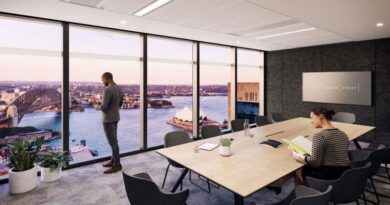Green Building Council of Australia Chair, Tony Arnel’s Speech From the AGM in November 2007
Prior to moving to the items of business for today, I would like to address the meeting:
Ladies and gentlemen, I am pleased to deliver the Chair’s Address for the Green Building Council of Australia for 2007.
The Council’s Objectives
The Green Building Council of Australia was formed in mid-2002 and essentially the Board embraced four objectives, which were to ensure that:
1. the financial integrity of the new organisation was maintained at all times;
2. green building rating tools would be produced as quickly as possible;
3. the Council would take all reasonable steps to mainstream green building technology into the design and construction phases of new commercial office buildings; and
4. the Council would take steps to educate designers, consultants, developers, building owners, state and local government officials and the property industry generally, in relation to the costs and benefits of green building initiatives through a series of seminars and courses.
Five years on, I am pleased to report that these objectives are well and truly being met.
We have achieved a great deal and the demand for the Council’s resources and services continues to grow exponentially as green building is embraced by industry and government alike.
The Green Building Council can justifiably claim to be the leading Australian authority on building green.
Addressing each of these objectives in turn, I offer the following comments.
Financial Integrity
The Council’s activities are funded by sponsorship, grants, membership subscriptions, training course revenue and events.
In 2002 the directors anticipated that the Council’s annual receipts would be approximately $450,000 per annum.
For the 2007 financial year, the Green Building Council’s total cash receipts were $4,520,323 exclusive of GST.
In simple terms, virtually every activity of the Green Building Council has to be self-funded. As an example, the Board will not commit to the development of a new rating tool unless the total costs are covered by sponsorship or grants. It is this strategy that has underpinned the Council’s increase in available funds; with this sure base, Green Star rating tool development has in this last year commenced for three new sector tools.
Bringing in strong membership subscriptions, the Green Building Council now boasts over 450 member organisations across the country, representing a broad cross-section of industry and government, including professional services, product manufacturers, suppliers, building controls and service contractors, government, contractors, developers, owners, investors, managers, higher education institutions, professional societies and utilities.
Total funding from industry and governments for sponsorship of Green Star tool development is valued at several million dollars, including recent key sponsorship from the South Australian Government for the development of Green Star – Healthcare and Green Star – Education rating tools, key sponsorship from Brisbane City Council and The Laminex Group for the Green Star – Multi-unit Residential rating tool, and key sponsorship from Goodman Group for the Green Star – Industrial rating tool.
RATING TOOLS:
The Green Building Council’s progress in developing rating tools has exceeded expectations. There are now seven Green Star rating tools available to download from the Council’s website. The complete range of rating tools for Class 5 Commercial office space is available online, with Green Star – Design and Green Star – As Built, along with Green Star – Interiors and the EXTENDED PILOT version of Green Star – Office Existing Building. Green Star – Shopping Centre Design PILOT has also been released for stakeholder feedback, and Green Star – Healthcare PILOT and Green Star – Education PILOT have also had PILOT projects across the country putting them through their paces before overall stakeholder feedback. Further Green Star rating tools are set for release in 2008.
In addition to the standard public review feedback process for PILOT rating tools, we have continued with the PILOT certification process, under which a limited number of projects can register for PILOT certification. We believe the opportunity to test the tools by assessing actual projects provides for a more robust rating tool when it is released in first version. Meanwhile, work is already underway on rating tools for more building classes, with the following three PILOT rating tools scheduled for launch in 2008:
Multi-unit Residential;
Mixed Use; and
Industrial.
The development of Green Star – Public Building, to include Convention Centres, Libraries, Cinemas, Theatres and Museums, begins in early 2008 and consideration is being given to future rating tools and their development process.
As of 29th October 2007 a total of 417 projects Australia-wide had registered for certification under Green Star. Of those, 37 have so far been awarded certification. 15 projects achieved Green Star certification during 2007. These included:
the first Green Star As Built certified projects for Adelaide (151 Pirie)
Two more 6 Star Green Star Buildings (one in ACT and one in SA)
as well as the first Green Star certified Project in WA (Westralia – 4 star)
Of those projects registered for Green Star certification, 272 have registered under the Green Star – Office Design rating tool; 67 have registered under Green Star – Office As Built; and 77 under the Green Star – Office Interiors tool. And 1 under Green Star- Office Existing.
Of the Certified Projects, 8 are 4 Star, 25 are 5 Star and 4 are 6 Star. We expect that many more projects will have been awarded Green Star Certified ratings before year’s end.
EDUCATION
Educating the industry about Green Star has continued to be a key objective for the GBCA and we held 92 Green Star Accredited Professional training courses during 2007. Of these, 42 were delivered as in-house training for GBCA Member organisations.
Courses have been in ever increasing demand, again selling out months in advance. Additional courses have been added to the calendar throughout the year. The option of in-house training has been extremely popular with member organisations – providing a fast-track solution to staff Green Star education.
Advanced courses have also gained momentum in 2007. The Office Interiors course was run in Perth for the first time, in addition to Sydney, Melbourne and Brisbane. The Submissions Workshop has been identified as an essential ingredient in the success of Green Star submissions. In order to promote this message to the market, We are now offering one free place per registered Green Star project.
In total the Council has trained over 7,150 people in the use of Green Star in 170 courses since the program started in October 2003. And as of November 2007, 1350 course participants have gone on to sit the competency examination and qualify as a Green Star Accredited Professional.
The Green Star for Property Professionals course is currently in trial phase and will be rolled out in 2008. This course is designed to equip Property Managers, Leasing Agents, Facility Managers and Chartered Surveyors and Valuers with an understanding of Green Star and how to best apply this knowledge to their own Industry sector. Topics covered include: Green Star Tools – Categories and Implementation, Valuing Green and Green Leases. This course will be held in capital cities throughout Australia in 2008.
2008 will also see the launch of a number of new advanced courses to compliment the introduction of new Green Star rating tools.
Additionally we will launch a series of Green Star building tours as a practical education initiative.
47 issues of the e-newsletter ‘Green Building Voice’ have been produced, which keeps Members up to date with the very latest news in national and international developments on green building.
There is strong demand for us to speak at conferences around the country, and at last tally, Council representatives had presented at more than 450 conferences, meetings or seminars.
In addition, the Green Building Council of Australia and the Property Council of Australia hosted the first Green Cities Conference and Expo from 11-14 February 2007. Held at the Sydney Convention Centre, this conference attracted over 900 delegates from across Australia and worldwide. Over 30 exhibitors also participated.
ADVOCACY
The GBCA Advocacy agenda for much of our work in 2007 was set by Green Cities 07 which included the need for Governments to understand the share of Australia’s GHG attributable to the built environment and consider a national emissions trading scheme that allows buildings to trade.
To support this the GBCA commissioned a report "Emissions Trading and the Built Environment" which will outline the importance of including the buildings in an emissions trading scheme.
Further, under the auspices of the Australian Sustainable Built Environment Council (ASBEC), which the GBCA are members, ASBEC commissioned the Centre for International Economics to investigate the potential for the building sector to reduce greenhouse gas emissions. This research is the first detailed estimate of the energy efficiency potential across the built environment in Australia.
The GBCA was also involved in the Built Environment Meets Parliament initiative developed by the GBCA, PIA, RAIA and PCA. BEMP will be an annual event held in Canberra between the peak Built Environment Groups and Federal Parliament to raise awareness of the built environment.
The GBCA is also finalising a report – Valuing Green – which will consider that the evidence is coming, but with many Green Star buildings still under construction, the data base for Valuers remains limited. Therefore, to be able to make informed judgements with limited information, valuers will need to share information in order to keep pace with the marketplace.
The GBCA is also working on Dollars and Sense Version 2 – due for release at Green Cities 08′.
The Council also welcomed David Gottfried back to help launch the Green Star Business Partnership, a world first initiative, Ten organisations have committed to achieving a minimum Green Star certified rating for all new office accommodation they own or occupy, as well as committing to a timeframe for raising the environmental performance of existing buildings to a Green Star rating. The organisations include
1) Colonial First State Global Asset Management;
2) DB RREEF;
3) GPT;
4) Investa;
5) ISPT;
6) Lend Lease;
7) Multiplex;
8) Stockland;
9) Sydney Harbour Foreshore Authority; and
10) Sydney Olympic Park Authority
INTERNATIONAL
The GBCA, as an active member of the World Green Building Council, is involved in a number of international projects including supporting the development of the South African GBC, the continued development of the NZ GBC, and participation in UNEP SBCI (United Nations Environment Program – Sustainable Buildings Construction Initiative). I was fortunate enough to represent the WGBC recently in Kuala Lumpur at the recent UNEP congress.
The GBCA is also overseeing the management of the International Day at next years SB08.
STRATEGY
At this years May Board meeting, The board set out the strategy for the next 5 years which included
Green Star
1. Develop, finalise and launch suite of rating tools
2. Establish quality control and maintenance systems for Green Star
3. Create clarity with ABGR, NABERS and other tools
4. Streamline Certification process and customer service program in place
Education
5. New Education courses introduced
Operations
6. Recruitment and retention strategy
7. Effective governance processes and corporate services
Advocacy & research
8. Release of a series of research projects/papers that continue to prove the business case
9. Establish state GBCA committees
10. Federal & State advocacy Strategy developed
Marketing – Events- Membership
11. GBCA Brands defined and a national & international communications strategy in place
12. Membership growth, diversity & retention
13. Successfully delivered Green Cities Conference
International
14. Collaboration with WGBC and other GBCs
15. International rating tool framework agreed
THANKS TO DIRECTORS
On behalf of the Board of the Green Building Council, I wish to register my sincere appreciation for the work done by my fellow directors on the various committees. In particular, I’d like to recognise the contribution of:
Ché Wall, who is Chair of the Technical Committee, and along with me sits on the World Green Building Council;
Michael Barnes, who is Chair of the Board’s Audit Committee;
Maria Atkinson, who is Chair of our Advocacy Committee;
Bill McHarg, who is Chair of the Marketing Committee;
Robert Coombs who is Chair of the Education Committee, and
Peter Verwer, who is Chair of the Technical Assurance Committee.
I would also like to recognise Directors who retired during the year;
– Craig Heaton, Chair in 2006, was a founding member of the Board, and
– Bob Nation from Nation Viney who moved to UAE
I would also like to welcome new board members
– Andrew Borger, Managing Director QLD with Leighton Properties
– Bill McHarg, Chairman of Colliers International Pty Ltd.
– Carey Lyon, Immediate Past National President of the Royal Australian Institute of Architects and founding Director of Lyons,
– David Worley, Chief Executive, The Laminex Group (TLG).
– Greg Paramor, Managing Director, Mirvac Group
– Molly Harriss Olson, Joint Director of Eco Futures and Convenor of the National Business Leaders Forum on Sustainable Development.
Thanks to Chief Executive and Her Staff
The Council’s team has grown from nine full-time staff to twenty Six, with assistance from seven part-time staff (up from four) and several consultants.
Tony Arnel, AGM November 2007







